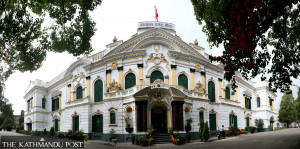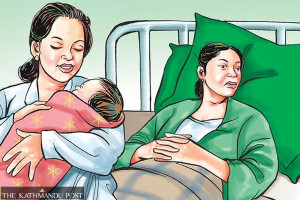Columns
Misreading the provinces
Attempts to further weaken the provincial sphere will result in the scrapping of federalism.
Ajay Das
February 2021 marks the completion of three years of the formation of the first-ever provincial governments under the recently adopted federal system in Nepal. During these years of implementing federalism, the country saw many vicissitudes on the political, legal and operational fronts. The federal and local governments are functioning relatively well, but the provincial governments have failed to win public trust, and they have been accused of imposing an unnecessary burden on the state coffers.
The constitution states, 'The relation between the Federation, Provinces and Local Levels shall be based on the principles cooperation, co-existence and coordination.' But there is neither coordination nor cooperation, and the dominance of the federal government continues to reign. In May 2019, Prime Minister KP Oli had warned local and provincial governments not to function as independent governments. He claimed that local and provincial governments were not separate entities but subordinate agencies under the federal government. And suiting the action to the word, the Oli administration authorised the chief district officers to exercise power under Panchayat-era laws during the height of the Covid-19 pandemic. They were empowered to act on behalf of the federal government and impose lockdowns in the districts that fall under the provincial governments.
Dual administration
The provincial governments were daunted by the dual administration. Implementing federalism in a low-income country was definitely a challenging task. Recently, questions have arisen over the necessity of the provinces. Provincial boundaries were carved out after years of fiery debates that contributed to widening the rupture in an already fractured society. The formation of local, federal and provincial governments after the elections brought the vehicle back on track to some extent. The federal system was adopted through rounds of political negotiations, but the Oli administration shifted the political gear to administrative gear in the provinces. Debates on administrative procedures and fiscal capacity dwarfed the political arrangements for devolution of power. A group of top leaders and bureaucrats were obviously against devolving power. They have a penchant for centralised power that they have been enjoying for decades. Being at the helm of power, these groups unwillingly accepted federalism and then scapegoated the provinces.
Based on the constitution, there was a dire need to clearly delineate the jurisdictions of the three spheres of government. From the onset, provincial governments were not able to fully function in the absence of comprehensive, full-fledged legal frameworks. Consequently, they were looking towards the federal government to play a facilitative role in identifying their rights and the concurrent rights of the federal, provincial and municipal levels. Provincial governments were not in a position to deliver and were dependent on the federal government to exercise their rights enshrined in the constitution.
The adjustment of civil servants to the provincial level has remained pending for a long time. The centralised mindset of the bureaucracy prevented civil servants from adapting to the new federal structures. A majority of them felt humiliated having to serve under local and provincial governments and remained accountable to the federal government. Those who agreed to go to the sub-national level hardly supported local and provincial governments. The ineffective management of civil servants under the new structures and insufficient infrastructure in the provinces forced provincial governments to operate in a hazy environment. Delays in the formation of a fully functional National Natural Resource and Finance Commission and long intervals between meetings of the Inter-State Council were contributing factors. The fiscal ability of the provinces were curtailed, preventing them from discharging constitutional responsibilities including making laws.
On the political front, single-party dominance proved to be counter-productive. Armed with sweeping powers, Prime Minister Oli appointed his close stalwarts to the driving seats of six of the seven provinces. The chief ministers of almost all the provinces are critical of the federal government’s regulatory approach and unsupportive responses, but they were reluctant to raise their voices against the Oli administration. Province 2 occasionally made calculated moves to challenge the federal government, but without much success. The chief ministers continue to converse about the challenges facing the provinces. But, going against the spirit of federalism, Oli is clearly indifferent to addressing their concerns.
Since the 2008 election to the Constituent Assembly, the country has been divided over the federal system of governance. There are two main reasons behind the declining confidence in federalism—a widespread public perception that the provincial sphere is irrelevant as it has become an additional strain on the state coffers, and the three-tier structure has been created to appoint a large number of political leaders to different positions. This misperception is taking a toll on sustaining federalism. Many tend to overlook the fact that federalism was adopted to accommodate the diversity of the country, and people prefer to be governed by their own kind and not always by Kathmandu in a unitary structure. They also disregard the fact that local and provincial governments are equally empowered by the constitution. Unfortunately, the sub-national governments are totally dependent on the federal government to exercise their rights enshrined in the charter.
Heart of federalism
The separation of powers and delegation of authority and resources between the three spheres of government lies at the heart of federalism. Provincial governments have not been able to deliver not because they are incompetent, but because they lack timely resource transfers, competent functionaries and a corresponding legal framework.
Nepal’s transition to federalism has a long way to go and requires political will power to gradually institutionalise it. Lopsided federal-provincial relations, where the centre continues to grow powerful and the provinces continue to function at the mercy of the centre, will ultimately make the provinces irrelevant. The weak federalised spheres of government will eventually make the federal system a failure. Federalism in Nepal is at the initial phase of putting down its roots, and there is a choice to make whether the powers of the provincial governments should be diluted or empowered to function as spelt out in the constitution. The fate of federalism depends on how hard the country tries to hold the three-tier structure together. Attempts to further weaken the provincial sphere will result in the scrapping of federalism.




 10.12°C Kathmandu
10.12°C Kathmandu















